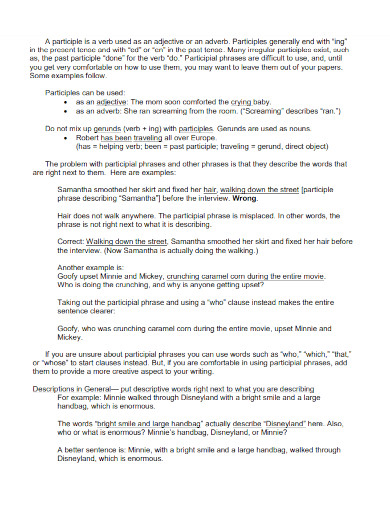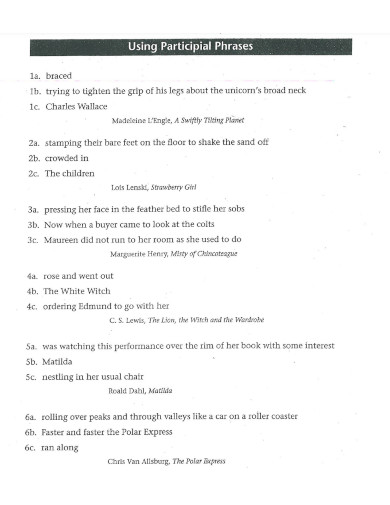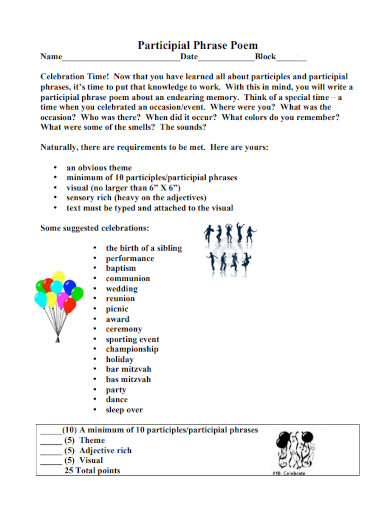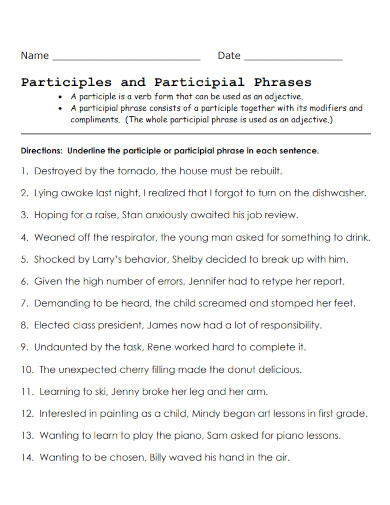5+ Participial Phrase Examples to Download
Participial phrases are important in writing and speaking because they add descriptive detail to sentences, making them more interesting and engaging for the reader or listener. By modifying proper nouns or pronouns with descriptive phrases, participial phrases can help paint a more vivid picture in the mind of the reader or listener.
1. Characteristics of the Participial Phrase
2. Participial and Other Phrases
3. Using Participial Phrases
4. Participial Phrase Poem
5. Participial, Gerund, and Infinitive Phrases
6. Underlining Participles and Participial Phrases
What is a Participial Phrase?
A participial phrase is a group of words that includes a participle (a verb form that functions as an adjective) and any accompanying modifiers and objects. One of its key characteristics is that it can be used to add description and detail to a sentence, often modifying the subject or object of the sentence. Participial phrases can be formed with either present or past participles and can be used in a variety of sentence structures, including as an opening phrase, a modifying phrase, or a conclusion phrase.
How do you use Participial Phrase?
Participial phrases can also help vary sentence structure and add sentence variety, which can help keep writing from becoming monotonous or repetitive. Additionally, using participial phrases can help writers and speakers convey a sense of action and movement, as the phrases often describe ongoing or completed actions.
Step 1: Identify the main subject and verb of the sentence
Before using a participial phrase, it is important to identify the main simple subject and verb of the sentence. Then, make sure they are structured with a subject-verb agreement. This will help you determine what aspect of the script or text structure you want to modify with the participial phrase.
Step 2: Choose a participle
Next, choose a participle that fits the tense and meaning of the sentence. Present participles end in -ing, while past participles typically end in -ed, -en, or -t. For irregular verbs, the past participle may take a different form altogether.
Step 3: Form the participial phrase
Combine the participle with any necessary auxiliary verbs and any accompanying modifiers or objects to form the participial phrase. This phrase should describe or modify the subject or object of the sentence in a way that adds detail or interest.
Step 4: Place the participial phrase in the sentence
Decide where to place the participial phrase within the sentence. It can be used as an introduction phrase, a modifying phrase, or a concluding phrase, depending on the desired effect.
Step 5: Ensure proper sentence structure and punctuation
Check that the statement has the appropriate punctuation and that it is grammatically accurate. This may require moving the participial phrase to a different location or, if necessary, putting commas before and after the phrase in order to set it apart.FAQs
How is a participial phrase used in a sentence?
In order to provide additional descriptive information and make the sentence more fascinating and engaging for the reader or listener, a participial phrase is used to modify a noun or pronoun in a sentence. Depending on the impact that you want to achieve, you may put it at the beginning, middle, or end of a sentence.
What are the different types of participial phrases?
There are two types of participial phrases: present participial phrases (ending in -ing) and past participial phrases (ending in -ed, -en, or -t).
What is the function of a participial phrase in writing or speech?
The purpose of a participial phrase is to provide description and detail to a sentence, to make it more fascinating and engaging, and to give the impression of motion and activity. Moreover, it may assist in varying sentence structure and adding diversity to sentences.
What are some examples of participial phrases?
Here are some examples of participial phrases: “Running late for the meeting,” “Baking a cake for her birthday,” “Amazed by the beautiful sunset,” “Frightened by the loud noise.”
In general, participial phrases are a helpful tool for writers and presenters who want to add depth and diversity to their language while also expressing a feeling of activity and movement in their writing or speaking.








